- Poetry School
- Posts
- Volume 5, No. 14: Put the Sky Back Inside the Poem
Volume 5, No. 14: Put the Sky Back Inside the Poem
winter wind, twilight rituals, art books, pastoralism, a new poem
Greetings, poetry people! Once again, I wrote this newsletter in bits and pieces throughout the week. It was a real joy, too. I hope you’re enjoying reading these collections of thoughts and reflections as much as I’m enjoying writing them.
In other news, I have three new poems out this week! And speaking of poems: thank you to everyone who has donated to my 30 Poems in November fundraiser. I have another poem to share with you today, and you can make donations through the end of the month here.
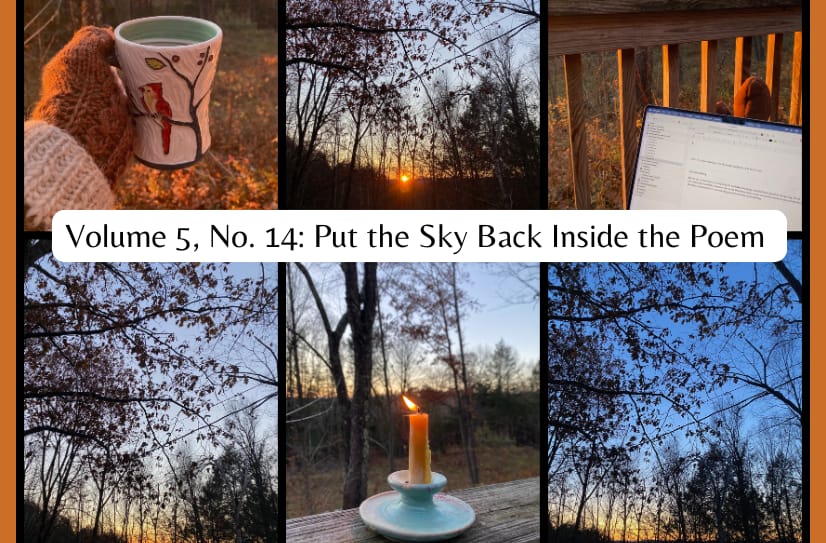
In this issue...
Donika Kelly, Garth Greenwell, & New Chambers
I just finished Donika Kelly’s new collection The Natural Order of Things and it was absolutely incredible. One of my favorite poems in it is called “I grew angry, I suffered, I resolved” and it’s about seeing Diana Damrau perform in the opera Lucia di Lammermoor at the Met in 2008. It ends like this: “I tell you, / I understood nothing before the great house / of her voice, and everything after.” Kelly elaborates even further in the note to the poem, in which she writes: “This was my first opera and, I say this without hyperbole, it changed the arc of my artistic life.”
I got shivers reading this poem. It made me think of one of my favorite passages from one of my favorite novels, Small Rain. The narrator is describing the experience of hearing a particular singer perform a particular piece of music for the first time, and he says: “It didn't just light some chamber of myself that had been dark, it made a new chamber, somehow, it made me capable of some feeling I couldn't have felt before.”
On Tuesday I got to hear the amazing Patrica Smith read at Smith. She said that she believes that poems can change your life, and then she said something that I will never forget. She said the thing you have to remember is that, when you read a poem, “real people are listening.” It is not a small or inconsequential thing. Real people are listening.
There was, for example, my life before I read Martyr!, and my life after. That book changed the artistic arc of my life. It opened new chambers. I was a real person, listening.
A Third, More Complicated Thing
I have a lot of domestic animal neighbors. Every day, walking with my dog and driving back and forth to school, I see them. My neighbors have goats, which they raise for meat. In with the goats are two guard dogs. Further up the hill, there’s a flock of chickens, two horses. Whenever I drive down the hill in the other direction, I see cows. For long stretches in the spring, summer, and fall, sheep are out on pasture in the fields around my house. If I take one route into Greenfield, I say hello to more cows and more horses. If I take the other, depending on the season, I wave at pigs, chickens being raised for meat, and ducks. I’ve learned to take a certain corner very slowly, because there are sometimes goats in the road.

Icelandic sheep at Knoll Farm in the summer of 2008
Earlier this fall I read Helen Whybrow’s beautiful memoir, The Salt Stones. I know Helen because I lived and worked for a summer at Knoll Farm, the hilltop farm where she has been raising sheep for almost 30 years. One of the threads I most appreciated in the book is the way Helen writes about pastoralism. Pastoralism—a way of life rooted in place and relationship, practiced by cultures all over the world for thousands of years—is a way of life currently under threat.
Helen reflects on the binary that dominates the way we interact with and think about domestic animals. They are either units of production that exist for the sole purpose of resource extraction for the benefit of humans (usually via incredibly violent means) or they are beloved pets, members of the family, cherished and individual. There is nothing in between.
A pastoral relationship with animals rejects this binary. Pastoralists have a different relationship with the animals they raise—it’s a third, more complicated thing. For a pastoral shepherd, sheep occupy a range of roles and relationships, often in direct contradiction to each other. Sheep are guides, teachers, individually known, loved. They are also livelihood: meat and wool. They are used for literal sustenance and they provide a kind of spiritual sustenance. They are not pets and they are not units of production, but something else, much stickier and harder to name.
I’ve been thinking about this as I go about my business alongside my domestic animal neighbors, and my human neighbors who live with them (care for them, sometimes kill them) in a messy web of relation. I am often afraid that we are losing our ability to hold contradiction, to hold nuance, to hold multiple, irreconcilable truths in our open hands. This terrifies me more than most other things. Pastoralism, as Helen describes it, and as she lives it, reminds me that humans have been doing this—the third, more complicated thing—for thousands of years, and that some of us, my neighbors included, are still doing it.
Art Book Stack
I started reading art books and exhibition catalogs last spring, and now I can’t get enough of them. GCC has a great art collection, and, even better, my professor (who is also a librarian) often brings a cart of books to class with her that we can check out right then and there. Unsurprisingly, my art book stack is currently quite unwieldy.
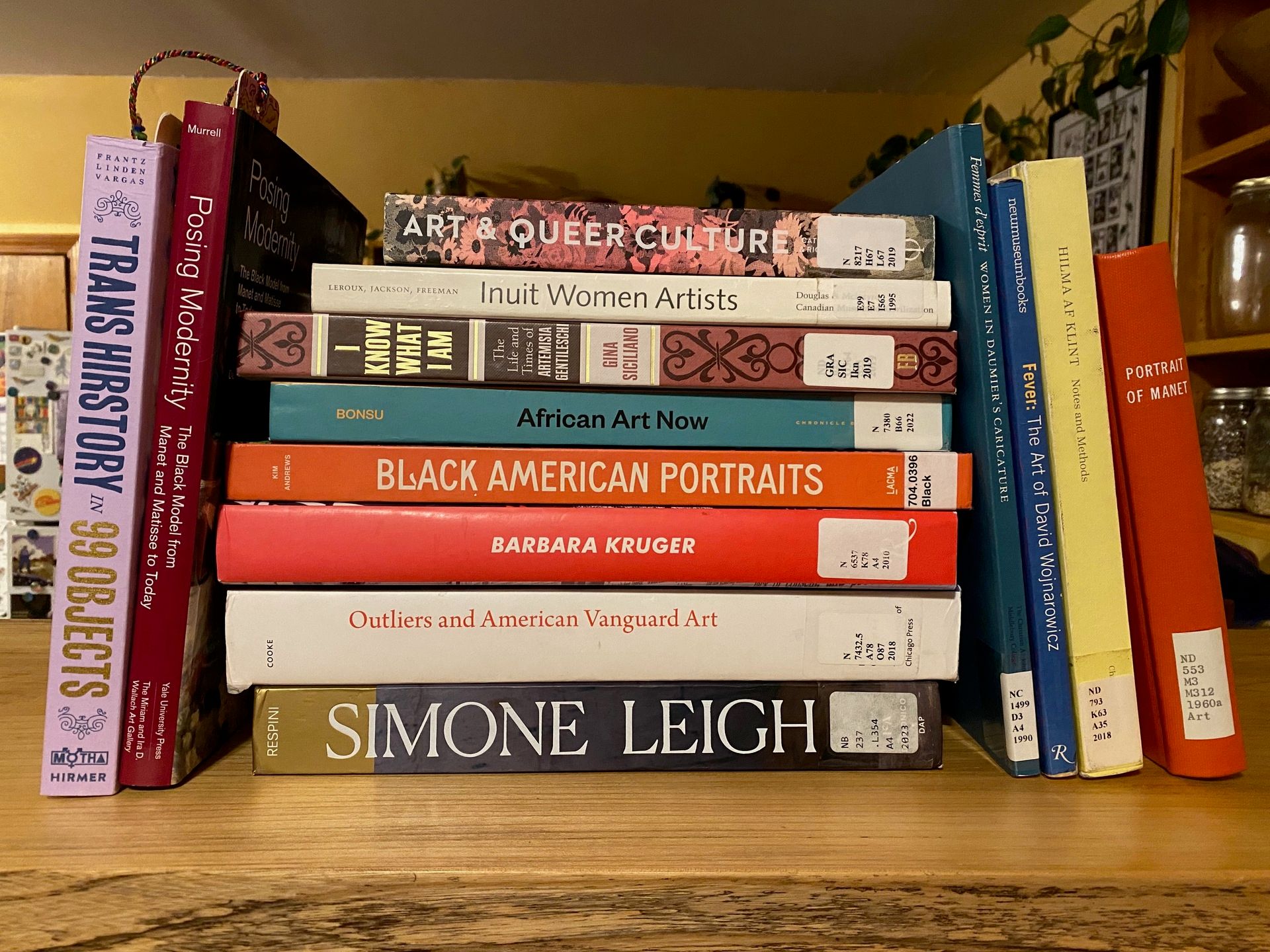
One thing I have learned is that there is A LOT of art in the world…
Here’s a bit more about the stack. Books marked with a * are ones I’m considering using for my research project in my history of modern art course.
Trans Hirstory in 99 Objects edited by David Evans Frantz, Christina Linden, and Chris E Vargas: I started this a while ago and put it on pause; now I’m back to reading a few pages every night and it is incredible. It introduced me to this painting, which I love.
*Posing Modernity: The Black Model from Manet and Matisse to Today by Denise Murrell: I haven’t stopped thinking about Olympia since my professor showed it to us last spring. So of course I’m using it as a springboard for my research project. I’ve been wanting to read this book since I heard Ama Codjoe talk about it on Between the Covers, and it is amazing so far.
Art & Queer Culture: I’m always thinking about this, so I checked out a book about it.
Inuit Women Artists: Voices from Cape Dorset edited by Marion Elizabeth Jackson, Odette Leroux, and Minnie Aodla Freeman: I just finished this book and I adored it. It appears to be out of print, but your library might have a copy! I loved the art and I loved the way the book was centered around the voices of the artists themselves. Below is a piece by Pitaloosie Saila, one of my favorite artists featured in the book.

Pitaloosie Saila, Summer Solstice, 2001
I Know What I Am by Gina Siciliano: A graphic novel about Artemisia Gentileschi?! Yss please!
African Art Now by Osei Bonsu: I picked this up on a whim at the library, partly because I was so tired of all the Europeans in this modern art class I’m taking.
*Black American Portraits edited by Christine Kim and Myrtle Elizabeth Andrews: I was thinking I might find a piece in here to focus on in my paper.
*Barbara Kruger: An artist I am considering writing about in my research paper!
Outliers and American Vanguard Art by Lynne Cooke: I picked this up from the library on the first day of school and still haven’t done more than flip through it…
*Simone Leigh: I’m considering looking at Leigh’s work in my research paper.
Femmes d’espirt: Women in Daumier's Caricature edited by Kristin H. Powell and Elizabeth C. Childs: My professor had this on her cart. I enjoy Daumier’s work. Now it is sitting on my shelf.
Fever: The Art of David Wojnarowicz edited by David Cameron: I saw this on the shelf and I needed it. The problem with needing to take home all these books is that I also need to read them.
Hilma af Klint: Notes and Methods edited by Christine Burgin: My professor had this book on her cart and I needed it.
*Portrait of Manet by Himself and His Contemporaries: This book collects letters and writings by Manet and his contemporaries…about my Manet! My professor tracked it down for me in the Five College library system. I’m excited!
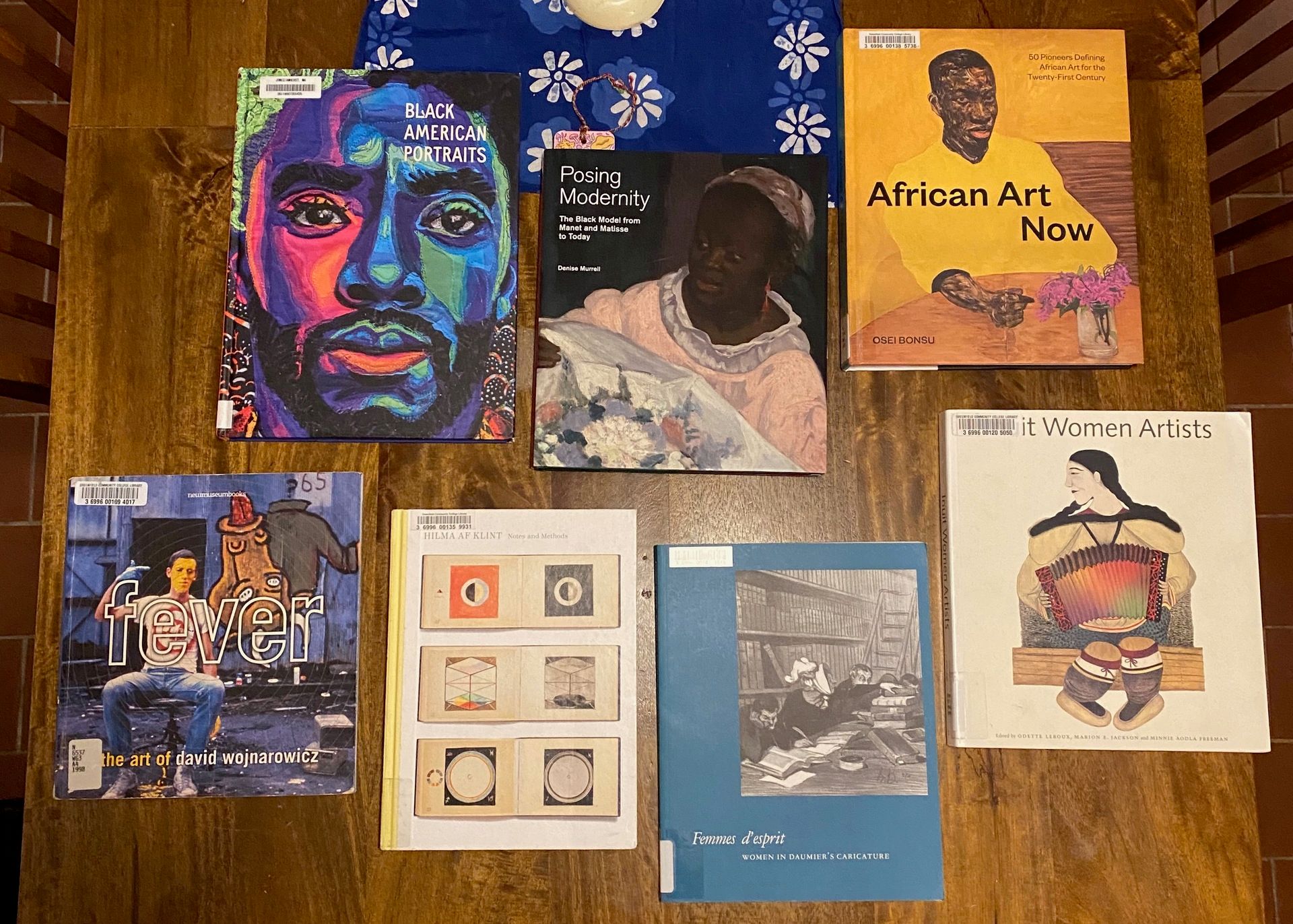
Anything here catch your eye? What should I read next?
A New Twilight Ritual
I have a lot of winter rituals I cherish, some of which I will share with you here over the next few weeks. Today I want to tell you a little bit about a new ritual: writing on my porch through the sunset and into the twilight. I’ve been thinking a lot about how few opportunities there are for us, in the structures we live inside, to actually experience the changing of the light. I’m lucky—I can often watch both the sunrise and the sunset, even in winter. Still, I sometimes get caught up in the stuff of the day: emails to send, projects to finish, dishes to wash.
Last week I decided to take an hour out of my day—from just before sunset until just after—to sit on my porch and write. I wanted to experience the twilight in my body. I wanted to feel the air changing, the sky darkening, the colors shifting. I wanted to see what sitting through this change, outside, on the porch, in the cold, would do to my poems. Spoiler: it was absolute and utter magic. I won’t do this every day, but, as often as I’m able, as deeply into the winter as I can, I’m going to make space to sit with the twilight.
Around 4pm, a half hour before the sun set, I made myself a warm beverage and bundled up in a sweater, hat, and slippers. I wrapped myself in a blanket and settled down on my porch.

In the golden light, as the sun sank lower and lower on the horizon, I started a poem.

I watched the sun set behind the trees and the hills.

When the last sliver of sun disappeared, I caught the spark and lit a candle.
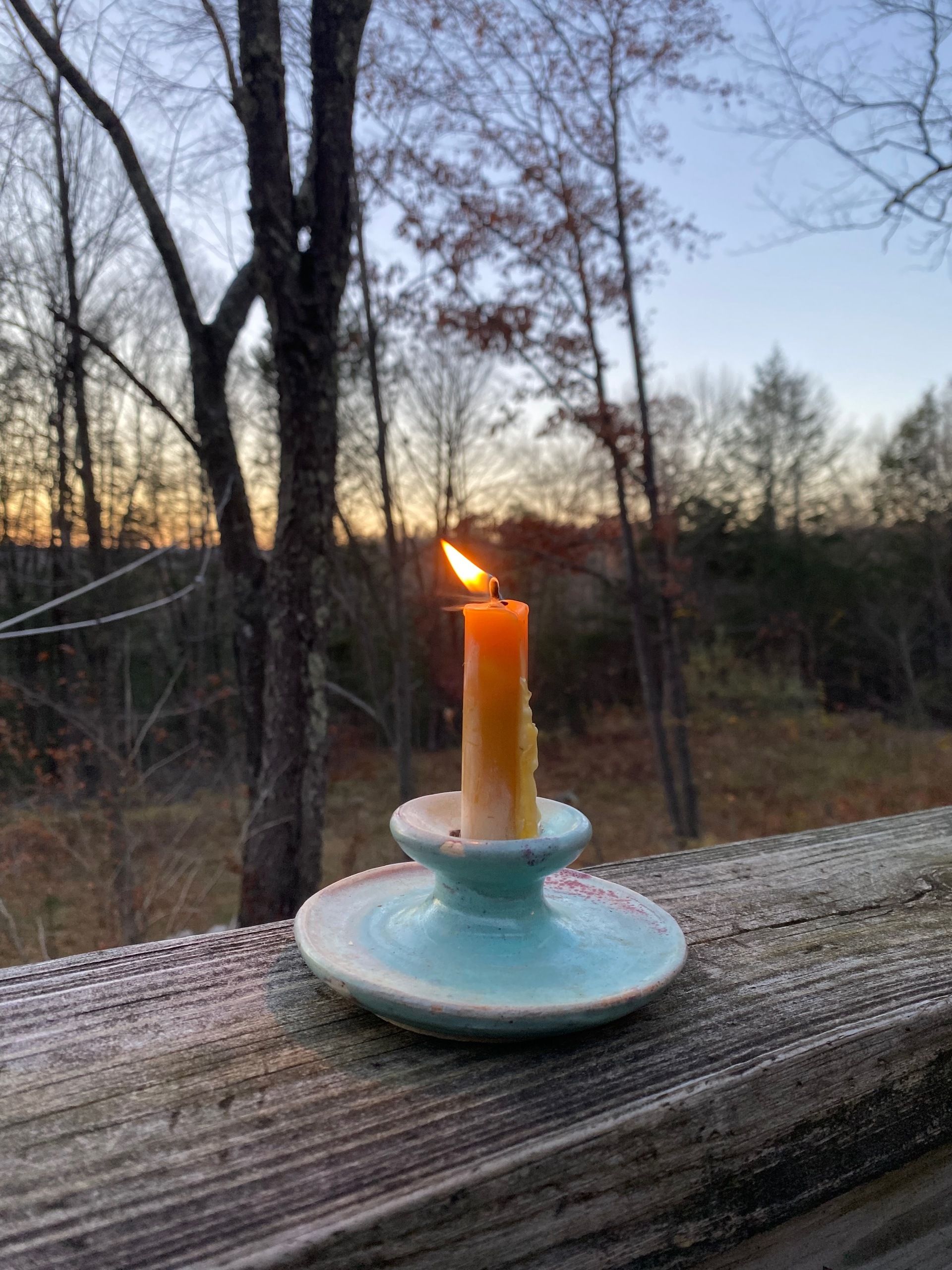
I wrote into the gathering darkness, as the sky turned from blue to almost-black. I wrote until the words quieted and my hands got cold.

Then I went inside, to the warmth and the light.
A Poem (in praise of slowness)
I’m still writing a poem every day as part of the 30 Poems in November! fundraiser for the Center for New Americans. I’m almost halfway to my goal of $500! If you’re able, you can donate here—I appreciate it so much.
I’m really enjoying the practice of writing a poem every day. It’s something I can’t really do for more than a month, but whenever I do it, I’m reminded of how good it feels. I spend so much time working the same poems and over and over. That’s important, and its own joy, but there’s something about committing to a small act of creation every day—a new one!—that I find exhilarating. A little respite. A different kind of flow.
Here’s a poem I wrote last week, inspired by a fantastic prompt from Mondays are Free.
In Praise of Slowness
It takes so much time to become
a tree. The way into the ground
is through music, & praising
the moon. Beloved, your every
bone bleeds time. The ground is
waiting. I am not the forest going
silent in the presence of a hawk.
I am not the wood thrush who begins,
again, to sing. Put the sky back
inside the poem, the ground inside
the sky. Touch me with your hands
of dirt. Someone I love left the world
with stones pouring from her mouth.
Someone I love left the world surprised.
Beloved, time does not belong to us.
What belongs to us is what we stitch
each other to. Touch me with your holy
mouth. The ground is soft & always
changing, watered ancient & made of leaves.
This separateness you feel is only
rain in the mountains, traveling home.
A Glimmer: Acoustic Music Jam
On Mondays and Wednesdays I have class in the morning and the early afternoon, so I stay at GCC in between and work in the library. For the first part of the semester, I always ate lunch outside near the gardens, but it’s gotten too cold for that, so I’ve been eating in the main lobby area, where there’s a perfect bank of chairs in front of some big windows.
A few weeks ago, there was a group of people with fiddles and guitars playing old folk songs in the lobby as I was eating. I thought it was some kind of special event and enjoyed the music. And then it happened again the next Wednesday. And again. And I realized that this was a regular thing. Every Wednesday, people gather to play acoustic music. Anyone is welcome. Last week the group included people in their 20s and 70s. Some people just sing. It lasts an hour. As I write this (having finished my lunch), they’re playing “I’ll Fly Away.”
This is the best thing that has happened to me in a long time. It is so wholesome and joyful. Every Wednesday I am utterly delighted by it.
A Calendar of Winter Joys: Wind
Last week I asked how I could be a candle for all of you in my writing during this season of darkness, the time of year I call the Season of Light. My friend Kristen had an idea I love: an advent calendar celebrating the joys of the season. In that spirit, I’m going to share one winter joy with you in each newsletter I write between now and the end of the year. Today’s winter joy: the wind.
I love winter wind. I love walking through a blustery winter wind on a sunny afternoon. I love the wind’s freshness on my face, the way it rushes through me with its wild, bright aliveness. Every zing and spark it leaves on my skin is a little reminder of aliveness. Winter wind wakes me up and puts me in my body. Here you are, it says, alive. Here you are, and isn’t it incredible, isn’t it miraculous, that you have a body that feels: warmth and the buzz of cold, the smoothness of water, the softness of leaves? The wind with its gorgeous demands for presentness, for attention, reminding me with its every breath on my face: you are alive, you are alive, you are alive.
It’s impossible to take a photograph of wind, but here I am on the Winter Solstice last year, a cold and silver day, the winter wind alive on my face.
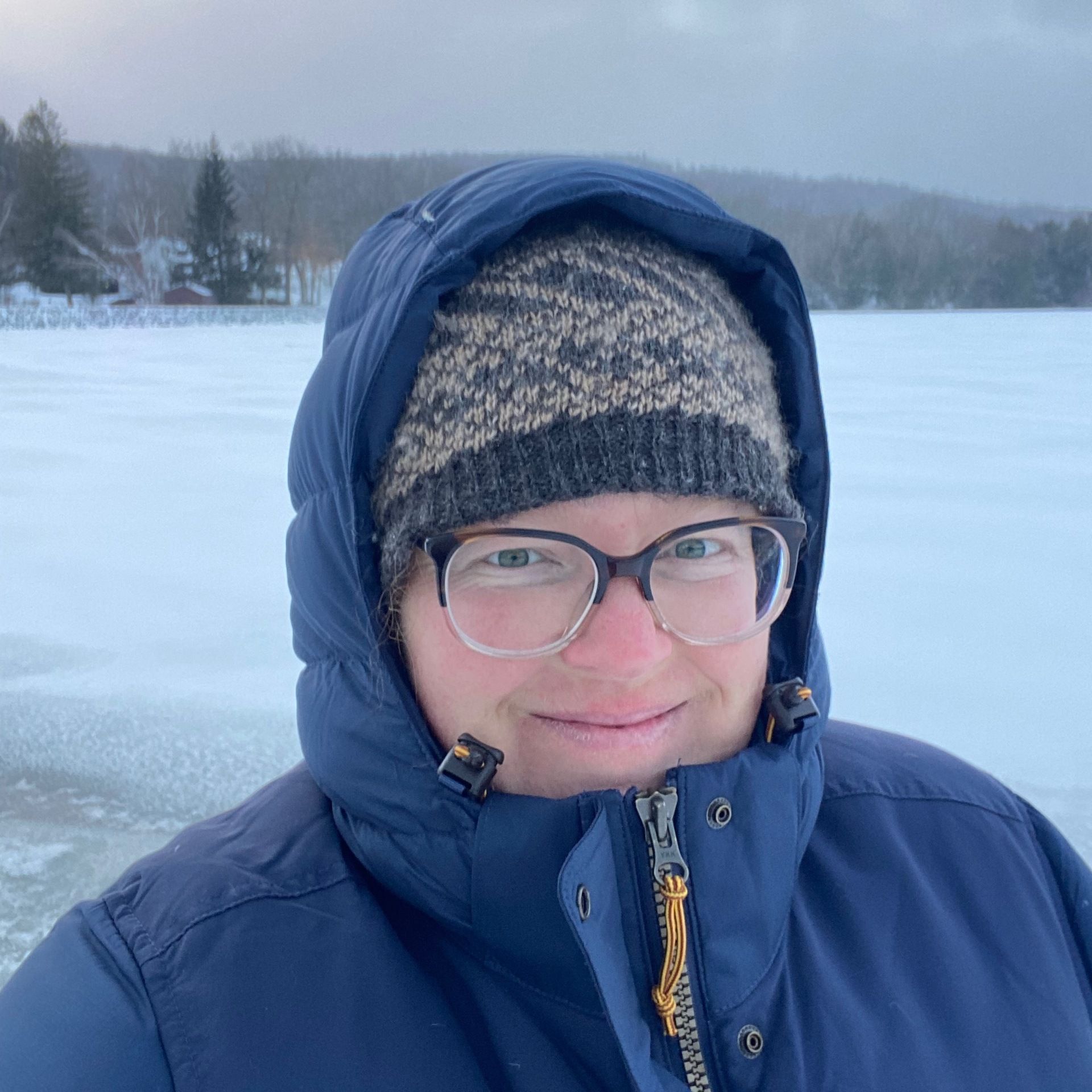
A Question / A Prompt
When I read this line in Donika Kelly’s new collection, in the poem ‘Self-Portrait: A Triptych’ I basically lost it: “The animals that come to live as my body—”
The whole poem is incredible. But this line will live inside me forever, growing. I immediately wrote a poem after it, using the line as the title. I’ve been doing a lot of this lately—titling a poem with a line I love, and going from there. So, here’s a prompt for you:
What animals have come to live as your body? Write a poem (or make a piece of visual art) that answers this question. Or, complete this sentence: “The animals that have come to live as my body are…” Or, write an anaphora poem, using the line as your repetition.
And Beauty
As always, a little bit of beauty to send you on your way: I came across this gathering of fungi-moths on a tree the other day and I am still not over it.
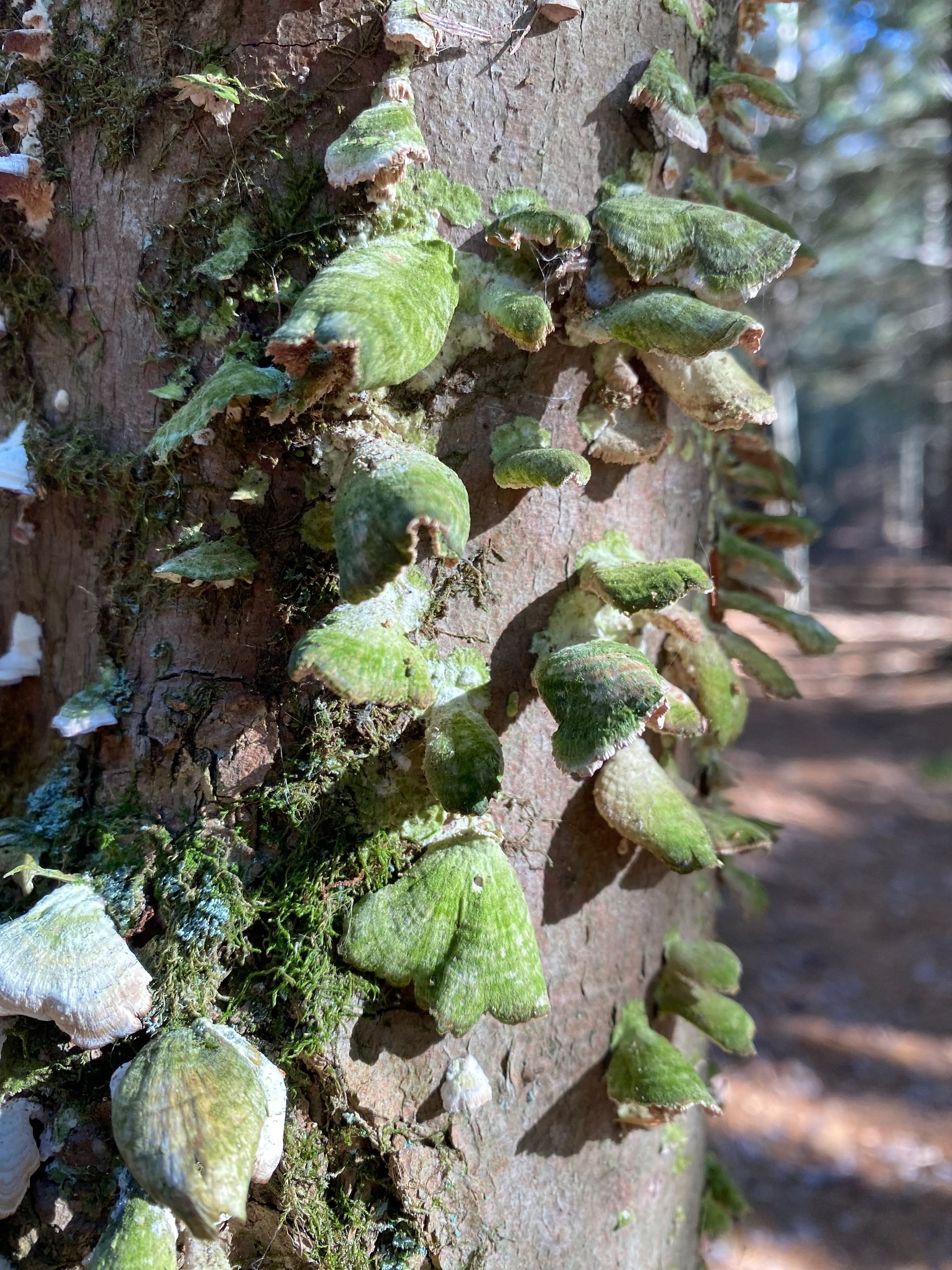
Thanks for reading, friends. Wishing you all sweetness and strength in this season of darkness and light.
Reply